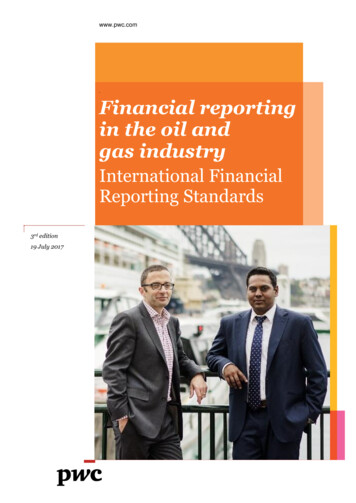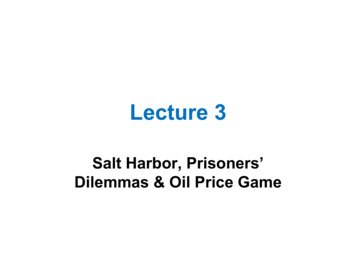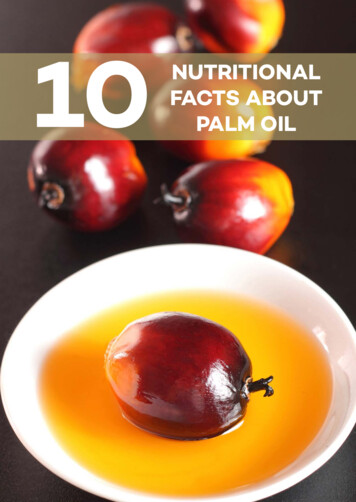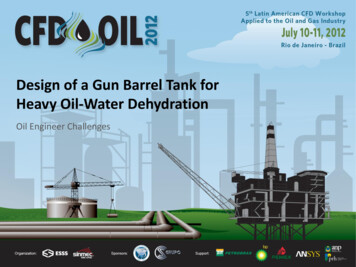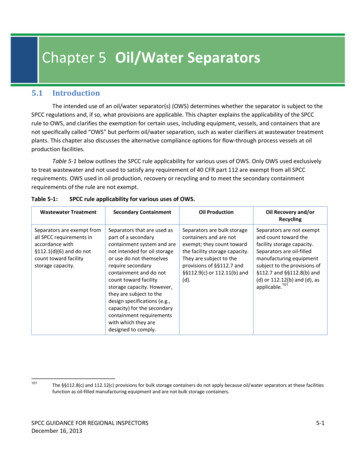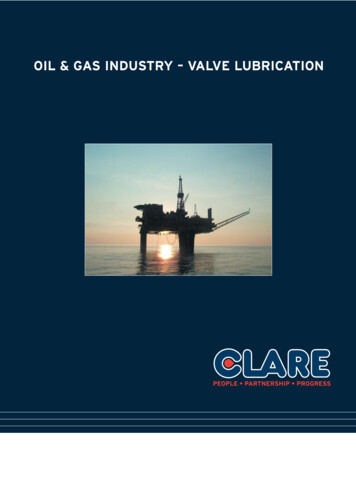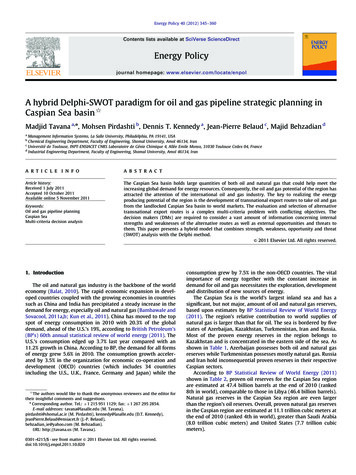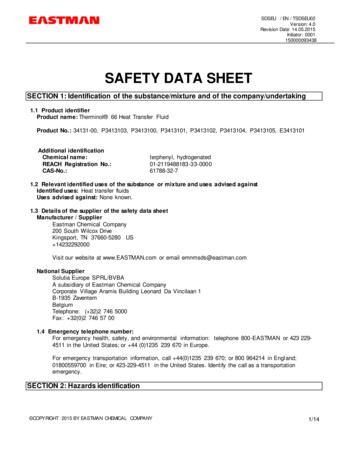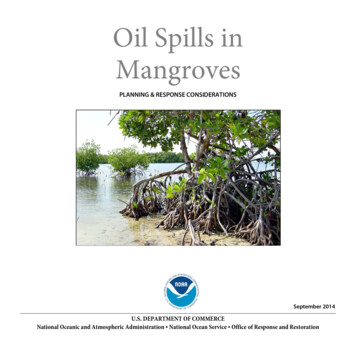
Transcription
Oil Spills inMangrovesPLANNING & RESPONSE CONSIDERATIONSSeptember 2014U.S. DEPARTMENT OF COMMERCENational Oceanic and Atmospheric Administration National Ocean Service Office of Response and Restoration
Oil Spills inMangrovesPLANNING & RESPONSE CONSIDERATIONSSeptember 2014Rebecca Hoff1 and Jacqueline Michel2, EditorsPhilippe Hensel3, Edward C. Proffitt4, and Patricia Delgado5 (Ecology)Gary Shigenaka1 (Toxicity)Ruth Yender1 and Jacqueline Michel2 (Response)Rebecca Hoff1 (Recovery and Restoration)Alan J. Mearns1 and Jacqueline Michel2 (Case Studies)Office of Response and Restoration, NOAA Ocean Service,National Oceanic and Atmospheric Administration, Seattle, Washington2Research Planning, Inc., Columbia, South Carolina3Johnson Controls World Services, National Wetlands Research Center, Lafayette, Louisiana4U.S. Geological Survey, National Wetlands Research Center, Lafayette, Louisiana5University of Louisiana at Lafayette, Lafayette, Louisiana1U.S. DEPARTMENT OF COMMERCENational Oceanic and Atmospheric Administration National Ocean Service Office of Response and Restoration
Table of ContentsINTRODUCTIONiCHAPTER 1. MANGROVE ECOLOGYKey PointsWhat is a Mangrove?Where are Mangroves and What do They Look Like?Mangrove EcotypesLife HistoryHabitat FunctionMangrove Economic Value and UsesAnthropogenic and Naturally Occurring ImpactsFor Further Reading1-11-11-11-11-51-61-111-131-141-18CHAPTER 2. OIL TOXICITY AND EFFECTS ON MANGROVESKey PointsOil GroupsMechanisms of Oil Toxicity to MangrovesAcute EffectsChronic EffectsMangrove Community ImpactsIndirect ImpactsSummary and Response ImplicationsFor Further Reading2-12-12-22-22-52-72-102-122-142-15CHAPTER 3. RESPONSEKey PointsOn-Water Response Options to Prevent or Reduce Mangrove OilingBoomsStranded Oil Behavior in MangrovesCleanup Options for Oiled MangrovesInappropriate Response Techniques for MangrovesFor Further Reading3-13-13-13-33-33-63-133-13CHAPTER 4. MANGROVE RECOVERY AND RESTORATIONKey PointsRecovery4-14-14-2
Mangrove RestorationFor Further ReadingCHAPTER 5. MANGROVE CASE STUDIESIntroductionZoe Colocotronis, La Parguera, Puerto Rico, 1973Peck Slip, Eastern Puerto Rico, 1978JP-5 Jet Fuel Spills, Roosevelt Roads, Puerto Rico (1986 and 1999)T/V Era, Spencer Gulf, South Australia, 1992Witwater and Texaco Storage Tank Spills, Bahía Las Minas, Panama, 1968 and 1986Bouchard Barge B-155, Tampa Bay, August 1993Guanabara Bay, Brazil, 2000M/T Solar I, Guimaras Island, The Philippines, 2006MANGROVE FiguresFigure 1.1. World map of the mangrove distribution zones and the number of mangrovespecies along each region (deltares, 2014).1-2Figure 1.2. Distribution of mangrove forests in the continental United States1-3Figure 1.3. Mangroves that occur in the U.S. and Caribbean1-4Figure 1.4. Various types of mangrove forests1-5Figure 1.5. Examples of mangrove seedlings that occur in the U.S. and Caribbean1-7Figure 1.6. Close-up of mangrove leaf showing salt crystals1-8Figure 1.7. Rhizophora tree showing prop roots1-9Figure 2.1. Acute oil toxicity effects2-7Figure 2.2. Propagule and root deformities observed in january 1980 as response to the chroniceffects of oil exposure after the 1978 Howard Star oil spill in Tampa Bay, Florida2-9Figure 2.3. Schematic diagram depicting the effects of a large oil spill on mangrove forests2-13Figure 3.1. Schematic showing the different patterns of oil spill impacts to mangrove forests3-4Figure 3.2. Infrared aerial photograph of a band of dead mangroves where oiling was heavieston the prop roots and penetrated into the soils3-4
Figure 3.3. Extensive riverine impacts to mangroves three years after the funiwa 5 spill of400,000 barrels of crude oil in Nigeria in 1980Figure 3.4. Vacuuming techniques in mangroves3-43-10Figure 4.1. Mangrove restoration project at West Lake Park, Ft. Lauderdale, Florida4-7Figure 5.1. Heavy oiling of red mangrove prop roots from the Peck Slip spill in Puerto Ricoin 19785-4Figure 5.2. Heavy oil stranding on the mangrove substrate and coating of the prop roots andpneumatophores5-13Figure 5.3. Heavy fuel oil from the M/T Solar I that penetrated completely through themangrove forest5-17TablesTable 1.1. Common mangrove species with common and scientific names and generaldistribution1-3Table 2.1. Oil groups and their characteristics2-3Table 2.2. Generalized responses of mangrove forests to oil spills2-8Table 3.1. Recommendations for response options in oiled mangroves by oil group3-6Table 4.1. Impacts and recovery times for mangrove trees at eight oil spills impacting fiveregions4-3Cover Photograph Credit: Felix Lopez, U.S. Fish and Wildlife Service
IntroductionINTRODUCTIONThis guide is intended to assist those who work in spill response and planning in regions wheremangrove ecosystems are an important part of the coastline. By understanding the basic of theecology of these forests and learning from past oil spills in mangroves, we can better plan for, protect,and respond to spills that may threaten them. Mangroves often border coastlines where coral reefslive offshore, and these two ecosystems are closely linked. Mangroves filter and trap excess sedimentthat could harm coral, and coral reefs protect shorelines where mangroves grow from excessive waveenergy. Both habitats can be adversely impacted by oil spills, and spill responders must often considertradeoffs between land-based and offshore resources during a response. This guide is a companion toOil Spills in Coral Reefs: Planning and Response Considerations.This guide is not intended to be a definitive guidance for choosing cleanup methods, as manycomprehensive versions of these exist already. Rather, it is a summary of current research onmangroves from the perspective of those who may need to make decisions about oil spill response inmangroves and presents the information in an accessible format for people with some science orresponse background. Experienced responders unfamiliar with mangroves may want background onmangrove ecology, while biologists may want an overview of oil toxicity and response actions appliedto mangrove ecosystems. The topics are organized by chapters, which can be read as a standalone,with additional references provided at the end of each chapter. A glossary defines specialized terms.Chapter 1 provides an overview of mangrove ecology, forest biology, associated mangrovecommunities, and how they respond to various natural and human stresses. Chapter 2 reviews theresearch on oil toxicity and impacts to mangroves. Chapter 3 discusses general guidance forresponding to spills in mangroves and provides specific considerations for cleanup measures. Chapter4 discusses long-term recovery of mangroves from oil spill impacts and restoration techniques andapproaches. Chapter 5 compiles case studies to illustrate a range of issues from oil spills.Mangrove forests are in many ways very adaptable ecosystems. They have the ability to tolerate a widerange of physical changes in their environment. However, despite their hardiness, they are highlyvulnerable to oil toxicity and the impacts from cleanup activities. Thus, we must undertake any type ofresponse or restoration activities in mangroves with caution. The information in this document will isintended to help minimize impacts to mangroves from oil spills and associated cleanup activities.i
Chapter 1. Mangrove EcologyCHAPTER 1. MANGROVE ECOLOGYMangrove – a tree orshrub that has evolvedthe adaptations forgrowing in the intertidalzone (specifically,adaptations to salinityand flooded conditions).Key Points Mangroves worldwide cover an approximate area of 150,000 squarekilometers of sheltered coastlines in the tropics and subtropics.Five of the most common ecotypes include fringe, basin, riverine,overwash, and dwarf forests.Mangroves are restricted to the intertidal zone.Mangroves in general have a great capacity to recover from major natural disturbances.Mangroves maintain water quality by trapping sediments and taking up excess nutrients fromthe water.Mangroves play an important role in shoreline protection and stabilization.Mangroves provide important habitat for a wide variety of species of commercial, recreational,subsistence, and conservation interestsMangrove conservation and restoration are now also valued for carbon sequestration.What is a Mangrove?Ecologically, mangroves are defined as an assemblage of tropical and semi-tropical trees and shrubsthat inhabit the coastal intertidal zone. A mangrove community is composed of plant species whosespecial adaptations allow them to survive the variable flooding and salinity stress conditions imposedby the coastal environment. Therefore, mangroves are defined by their ecology rather than theirtaxonomy. From a total of approximately 20 plant families containing mangrove species worldwide,only two, Pellicieraceae and Avicenniaceae, are comprised exclusively of mangroves. In the familyRhizphoraceae, for example, only four of its sixteen genera live in mangrove ecosystems (Duke 1992).Where are Mangroves and What do They Look Like?Mangroves worldwide cover an approximate area of 150,000 square kilometers (km2) of shelteredcoastlines, which is about 50% of their historic range (Spalding et al. 2010). They are distributed withinthe tropics and subtropics, reaching their maximum development between 25 N and 25 S (Figure 1.1).Their latitudinal distribution is mainly restricted by temperature because perennial mangrove speciesgenerally cannot withstand freezing conditions. As a result, mangroves and grass-dominated marshesin middle and high latitudes fill a similar ecological niche.1-1
Chapter 1. Mangrove EcologyFigure 1.1. World map of the mangrove distribution zones and the number of mangrove species along each region (Deltares, 2014).The global distribution of mangroves is divided into two hemispheres: the Atlantic East Pacific and theIndo West Pacific. As seen in Figure 1.1, the Atlantic East Pacific has fewer species than the Indo WestPacific (12 compared to 58 species, respectively). Species composition is also very different betweenthe two hemispheres. Out of a total of approximately 70 mangrove species, only one, the mangrovefern, is common to both hemispheres.In the continental United States, mangroves historically were distributed as distinct forests along theAtlantic and Gulf coasts of Florida. However, their range has expanded, with black mangrove forestsnow present in large numbers in southern Texas and Louisiana (Figure 1.2), mainly because of thedecrease in the frequency and severity of hard winter freezes along the coast (Osland et al. 2013).More recently, red mangroves have started to appear in Texas. Mangroves also occur in Puerto Rico,the U.S. Virgin Islands, Hawaii, and the Pacific Trust Territories. There are 1,900 km2 of mangroves alongthe Florida coast, with the most developed forest occurring along the southwest coast. The Gulf ofMexico and Caribbean regions are characterized by four dominant species (Table 1.1 and Figure 1.3):Rhizophora mangle (red mangrove), Avicennia germinans (black mangrove), Laguncularia racemosa(white mangrove), and Conocarpus erectus (button-mangrove or buttonwood). Black mangroves rangefurther north than the other species because of their greater tolerance to low temperatures andability to recover from freeze damage (Markley et al. 1982; Sherrod et al. 1986). Osland et al. (2013)predict that an increase in winter minimum temperatures may lead to black mangroves replacing saltmarsh along portions of the Texas, Louisiana, and Florida coasts.1-2
Chapter 1. Mangrove EcologyFigure 1.2. Distribution of mangrove forests in the continental United States based on data from 2006 for Texas and Louisiana and 2004for Florida (Osland et al. 2013).Table 1.1. Common mangrove species with common and scientific names and general distribution in the US and Caribbeanregions.Scientific nameRhizophora mangleAvicennia germinansCommon nameRed mangroveBlack mangroveLaguncularia racemosaConocarpus erectusAcrostichum aureumWhite mangroveButtonwoodMangrove fern1-3DistributionCaribbean, FL, TX, HI (non-native)Caribbean, FL, TX, LA, MS, American Pacific TrustTerritoriesCaribbean, FL, American Pacific CoastCaribbean, FLCaribbean, FL
Chapter 1. Mangrove EcologyFigure 1.3. Mangroves that occur in the U.S. and Caribbean. A) Rhizophora mangel (red mangrove) showing the classical tangle ofprop roots. B) Avicennia marina (black mangrove) showing the diagnostic presence of pneumatophores. C) Lagunculariaracemosa (white mangrove). D) Conocarpus erectus (buttonwood mangrove (A, B Research Planning, Inc. and C, D RobinLewis), Lewis Environmental Services, Inc.).1-4
Chapter 1. Mangrove EcologyMangrove EcotypesMangroves colonize protected areas along the coast such asdeltas, estuaries, lagoons, and islands. Topographic andhydrological characteristics within each of these settingsdefine a number of different mangrove ecotypes. Five of themost common ecotypes include fringe, riverine, basin,overwash and dwarf forests as shown in Figure 1.4 (Lugo andSnedaker 1974; Twilley 1998). A fringe forest bordersprotected shorelines, canals, and lagoons, and is inundatedby daily tides. A riverine forest flanks the estuarine reachesof a river channel and is periodically flooded by nutrient-richfresh and brackish water. Drainage depressions in theinterior of mangrove areas harbor basin forests,characterized by stagnant or slow-flowing water. Overwashforests are islands frequently inundated or washed over bytides. Dwarf or scrub forests grow in areas where hydrologyis restricted, resulting in conditions of high evaporation,high salinity, or low nutrient status. Low temperatures at thenorthern ranges of mangrove species distribution can alsoresult in “scrub” mangrove areas in fringe, basin, riverine,and overwash settings. Such stressful environmentalconditions stunt mangrove growth.Each of these mangrove ecotypes is characterized bydifferent patterns of forest structure, productivity, andbiogeochemistry, all of which are controlled by acombination of factors such as hydrology (tides, freshwaterdischarge, rainfall), soil characteristics, biologicalinteractions, and the effects of storms and otherdisturbances.Figure 1.4. Various types of mangrove forests (modified from Lugo andSnedaker 1974).1-5
Chapter 1. Mangrove EcologyHermaphroditic – Bothsexes present in anindividual organism.Life HistoryVivipary – The conditionin which the embryo (theyoung plant within theseed) germinates whilestill attached to theparent plant.Most mangroves are hermaphroditic (both sexes are present in an individualorganism). Mangroves are pollinated almost exclusively by animals (bees,small insects, moths, bats, and birds), except for Rhizophora, which isprimarily self-pollinated (Lowenfeld and Klekowski 1992). In mostmangroves, germination takes place while the embryo is still attached to theparent tree (a condition called vivipary). The embryo has no dormant stage,but grows out of the seed coat and the fruit before detaching from the plant.Because of this, mangrove propagules are actually seedlings, not seeds(Figure 1.5).Propagule – Seedlinggrowing out of a fruit;this process begins whilethe fruit is still attachedto the tree.Mangrove Reproduction and GrowthVivipary as a life history strategy helps mangroves cope with the varyingsalinities and frequent flooding of their intertidal environments, and increases the likelihood thatseedlings will survive. Since most non-viviparous plants disperse their offspring in the dormant seedstage, vivipary presents a potential problem for dispersal. Most species of mangroves solve thisproblem by producing propagules containing substantial nutrient reserves that can float for anextended period. In this way, the propagule can survive for a relatively long time before establishingitself in a suitable location (McMillan 1971; Tomlinson 1986).Buoyancy, currents, and tides disperse mangrove propagules and deposit them in the intertidal zone.Once established, the numerous seedlings face not only the stresses of salinity and variable flooding,but also competition for light (Smith 1992). These, in addition to other sources of mortality, cause verylow survival rates for seedlings and saplings. Determining the age of mangroves is difficult, butflowering individuals have been recorded as young as 1.5 years old. Tree growth, survival, and theensuing forest structure are determined by the mangrove forests’ ecotype.There are few estimates of mangrove forest turnover (the time required for the forest to replaceitself). Despite a precarious existence in the intertidal zone, Smith (1992) estimates mangroveturnover at 150-170 years. For comparison, an estimate for turnover in lowland tropical rainforests isabout 118 years (Hartshorn 1978).1-6
Chapter 1. Mangrove EcologyFigure 1.5. Examples of mangrove seedlings that occur in the U.S. and Caribbean. A) Rhizophora mangle (red mangrove). B)Avicennia marina (black mangrove). C) Laguncularia racemosa (white mangrove). D) Conocarpus erectus (buttonwood mangrove.(Robin Lewis, Lewis Environmental Services, Inc.).1-7
Chapter 1. Mangrove EcologyEvapotranspiration –The transfer of waterfrom the soil, through aplant, and to theatmosphere through thecombined processes ofevaporation andtranspiration.Transpiration is aprocess of water lossthrough leaf stomatalopenings.Adaptations to SalinityMangroves can establish and grow under a relatively wide range of floodingand salinity conditions; however, they are generally restricted to theintertidal zone where there is less competition with freshwater plants.Mangroves have developed a series of physiological and morphologicaladaptations that have allowed them to successfully colonize theseenvironments.Mangroves do not require salt water to survive, but because of poorcompetition with freshwater vegetation and unique adaptations to theintertidal zone, they are generally found under the influence of salt water.Salinity is mainly determined by local hydrology, where input of salt water comes from the periodictides and fresh water comes from rivers, rainfall, groundwater, and runoff. High evapotranspiration(water loss through the soil and plant leaves) in the tropics and subtropics can increase salinityconsiderably, especially under environments with restricted water flow. Thus, salinity can fluctuatewidely within mangrove forests, both over time and space.Mangroves have evolved different mechanisms to toleratehigh salinities: salt exclusion, salt secretion, and tolerance ofhigh salt concentrations within plant tissues are the mainstrategies. Most mangroves have developed all threemechanisms, although to varying extents. Rhizophora,Bruguiera, and Ceriops have root ultra-filters that exclude saltwhile extracting water from soils (Rützler and Feller 1996).In salt secretion, special organs or glands remove salts fromplant tissues. For example, Avicennia and Laguncularia havespecial, salt-secreting glands that cause salt crystals to formon the leaf surfaces (Figure 1.6). These crystals then can beblown away or easily washed away by the rain. Leaf fall isanother mechanism for eliminating excess salt inmangroves (Kathiresan and Bingham 2001).1-8Figure 1.6. Close-up of mangrove leaf showing saltcrystals (C.E. Proffitt; Gulf of Fonseca, Honduras).
Chapter 1. Mangrove EcologyAdaptations to FloodingMangrove forests are periodically flooded, with the frequency andmagnitude of flooding determined by local topography combined with tidalaction, river flow, rainfall, surface runoff, groundwater, andevapotranspiration. As with salinity, hydrology in mangrove ecosystemsvaries greatly in time and space, and mangrove species differ in their abilityto tolerate flooding.At the intertidal scale, the magnitude and frequency of flooding decreasesin a landward direction. Mangrove species often show a distinctivedistributi
MANGROVE RECOVERY AND RESTORATION 4-1 Key Points 4-1 Recovery 4-2. Mangrove Restoration 4-4 . T/V Era, Spencer Gulf, South Australia, 1992 5-8 Witwater and Texaco Storage Tank Spills, Bahía Las Minas, Panama, 1968 and 1986 5-9 Bouchard Barge B-155, Tampa Bay, August 1993 5-13 Guanabara Bay, Brazi


